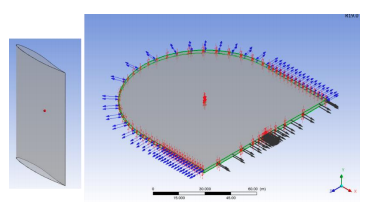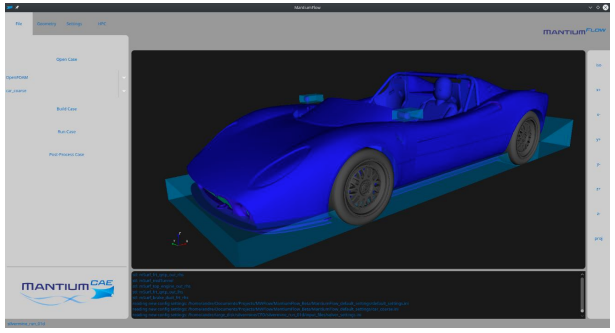The first functional computational fluid dynamics (CFD) computer simulation model was developed in 1957 at the Los Alamos National Lab. It took another decade for Douglas Aircraft to fine tune a three-dimensional CFD analysis model, and Boeing further honed the technology in the 1970’s. It was not until 1995 that Ford and GM started using CFD for automotive design.
Today, CFD plays an important role in the design and analysis of transportation products for the air, ground and sea. For example, in commercial aircraft, CFD is vital for designing the high-speed wing and its integration with the aircraft engine, along with icing models and conjugate heat transfer. Meanwhile automotive designers use CFD for predicting aerodynamic forces and designing aerodynamic shapes.
Increasingly used in multidisciplinary design, CFD offers engineers a more efficient and less expensive alternative to wind tunnel testing. Unlike wind tunnels, CFD can be used to run some simulations in a matter of minutes, and to test performance in extreme conditions that cannot be reliably replicated by a wind tunnel.
But CFD still comes with challenges. Although accuracy and computing speed has greatly improved since the 1990’s, most engineers still lack access to the computing power necessary to run timely, comprehensive CFD simulations at their individual workstations.
Cloud-based CFD software offers an attractive solution to this issue. Engineering teams can scale up using cloud HPC to run simulations faster than ever, with little to no setup time thanks to UberCloud technology. Research teams have already used UberCloud technology to successfully execute CFD simulations much more quickly, directly from their web browsers, as demonstrated in the three case studies below.
Racing Car Airflow Simulation on the Advania Data Centers Cloud
 |
| The figure above illustrates the velocity distribution plot at the mid-section of the racing car. |
Air velocity impacts a racing car’s stability, and this case study focused on understanding the aerodynamic performance and other forces acting on a racing car at different speeds. The CFD analysis provides an in-depth look at the air flow, pressure, and velocity distribution around the car, along with the parameters required to calculate the aerodynamic forces.
A 3D CAD model of the racing care and a dummy driver were modeled as part of the project.
CFD models were generated using the ANSYS 19.0 simulation environment, accessed using a VNC viewer through the user’s web browser. ANSYS Fluent was running in UberCloud’s HPC application software containers in the Advania Data Centers HPCFLOW cloud.
The researchers learned that using the HPC cloud computing environment with ANSYS 19.0 Workbench made model generation very easy, and processing times were reduced drastically as HPC resources increased. The team also noted additional benefits:
- Producing a highly fine mesh (100+ million cells) requires computational resources that exceed the capacity of a normal workstation. The HPC cloud allowed the team to solve highly fine mesh models, while simultaneously getting simulation results within an acceptable run time (about 1.5 hours).
- Accessed via VNC Controls in a web browser, the HPC Cloud was very intuitive to use, with minimal or no installation of prerequisite software. The whole user experience was similar to accessing a website through the user’s own workstation browser.
- The UberCloud containers contributed to smoother execution of the process and easy access to service resources. This proved a huge advantage for users, who could continuously monitor jobs in progress without having to set up server tools on the desktop.
Aerodynamic Study of a 3D Wing Using ANSYS CFX
The aerodynamic study of an aircraft wing examines the air flow and the forces acting on the wing due to air velocity. The study mainly provides in-depth insights on the air flow, pressure, and velocity distribution around the wing, along with the parameters necessary to calculate the lift and drag forces.
 |
 |
| The top image is a 3D geometry of the wing. The bottom image is the CFD mesh model created in ANSYS CFX. |
For this case study, the researchers evaluated the wing aerodynamic performance for a standard wing profile. The CFD models were generated in the ANSYS environment. The cloud environment was accessed using a VNC viewer through the user’s web browser. The ANSYS software was running in UberCloud’s application software containers, which give users instant interactive access and use of the ANSYS cloud environment.
Mesh models were generated for different cell numbers where the experiments were performed using moderate fine, fine, to highly fine mesh models. The HPC computing resource helped achieve smoother completion of simulations without re-trails or resubmission of the same simulation runs. Researchers noted multiple additional benefits:
- Using ANSYS Workbench in the HPC cloud computing environment made model generation much easier, and process time was drastically reduced thanks to the HPC resource.
- The use of ANSYS Workbench also helped in performing different iterations in experiments by varying the simulation models within the Workbench environment. This further increased efficiency of simulation setup, providing a single platform to perform end-to-end simulation model development and setup.
- Experiments performed in the HPC cloud provided extra confidence regarding the potential for setting up and running simulations remotely in the cloud. The different simulation setup tools required were pre-installed in the HPC container environment, enabling users to access the tool without any prior installations.
Aerodynamic Simulations using MantiumFlow and Advania Data Center's HPCFLOW Technology
This case study shows how Advania’s HPCFLOW computing resources allowed MantiumCAE to create a CFD simulation quickly and efficiently for the Silvermine 11SR sportscar. To achieve this, MantiumCAE set up a CAE computing environment in Advania’s HPCFLOW cloud, where simulations could be carried out quickly and efficiently.
 |
| MantiumCAE created and carried out CFD simulations for the Silvermine 11SR using Advania's HPCFLOW. |
A typical external vehicle aerodynamics simulation needs between 2,000 and 10,000 CPU core hours to be processed. Processing this simulation would take weeks to run on a 16-core workstation, but by using the HPCFLOW cloud environment together with MantiumFlow, MantiumCAE is able to deliver results within one business day.
By successfully using Advania’s HPCFLOW technology, MantiumCAE was able to execute HPC CAE projects on a scale that was previously unattainable, and with a flexibility that allowed them to serve their clients’ needs better and faster. This was done without any upfront investment in computers or facilities, and has secured their existing business, opened new markets and positioned them well for future growth.
To read these full case studies, get UberCloud's Fifth Annual Compendium. This year's collection features case studies based on 13 select UberCloud Experiments, and the whole project is sponsored once again by Hewlett Packard Enterprise and Intel.



